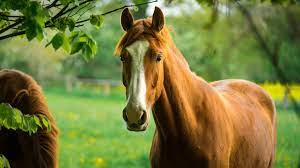Before Christopher Columbus' great discovery, there were no horses in either the northern or southern parts of the continent. Only the third expedition brought some to the Caribbean islands. Of domestic animals they had dogs, llamas and turkeys - not even chickens.
Horses

Before Christopher Columbus' great discovery, there were no horses in either the northern or southern parts of the continent. Only the third expedition brought some to the Caribbean islands. Of domestic animals they had dogs, llamas and turkeys - not even chickens. Therefore, at the sight of riders in steel armor, armed with firearms, the Indians panicked and ran away. How can you not believe in the divine nature of the alien?
Researchers of ancient fossils assure that before the beginning of time horses lived on both halves of the continent, they often find their bones. But then something happened and the species died out without a trace. Modern Eurasian and African horses are said to be descended from North American ancestors. There was once an isthmus between America and Asia in what is now the Bering Strait between Kamchatka and Alaska. Using this land bridge, herds of wild horses migrated freely. But then the sea returned and the route ceased to operate.
The Indians are to be commended - the deification story ended rather quickly. Like Europeans, they soon learned to ride and shoot and did it as well as the pale-face (or even better).
Some of the horses, left without owners, became feral and became mustangs. Some even believed that they were Native American mares - which, however, is a misconception. With the beginning of the 20th century, feral horses were almost completely exterminated and, like Indians living on reservations, locked up on reservations.
Hard liquor

Native Americans lived a simple way of life, without perversions. The structure resembled a primitive communal one, a chief stood at the head of the tribe, and for the time of military operations they elected one more - a marching chief. A shaman was in charge of rituals.
The locals knew little about alcohol, and had no means of making hard liquor. Therefore, European colonizers, under the guise of friendly meetings that turned into drinking, deceived the chiefs, and those inebriated agreed to exchange assets belonging to their tribes for trinkets and gibberish.
Take Manhattan, an island in the center of the Big Apple. Europeans from Holland bought it from seven local tribal chiefs for a few dozen glass beads, twelve knives, and two muskets.
Once drunk, the Indians, whose metabolism had difficulty coping with the alcohol, were forever enslaved, first to firewater and then to white fever. It's been that way ever since.
Wheeled transport

Despite the fact that toys and pottery wheels have often been found in excavations, historians claim that pre-Columbian America did not know road transportation. It is understandable: there were no good roads on the continent, and cities were often built among hills or in the thick of forests, which was designed to strengthen defensive positions. Pack llamas were used as transportation, as they were highly passable, able to cross mountain passes and pass through narrow paths where a cart would have no place.
This continued until the Spaniards, Dutch, English and French arrived from Europe and needed large roads and cities.


















